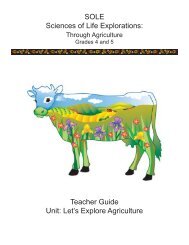Insect Anatomy - Agriculture in the Classroom
Insect Anatomy - Agriculture in the Classroom
Insect Anatomy - Agriculture in the Classroom
Create successful ePaper yourself
Turn your PDF publications into a flip-book with our unique Google optimized e-Paper software.
name____________________________<br />
Student Lesson: <strong>Insect</strong> <strong>Anatomy</strong><br />
W<strong>in</strong>gs<br />
Bats are mammals that fl y. Their w<strong>in</strong>gs are<br />
unlike any bird or <strong>in</strong>sect. They fl y with <strong>the</strong>ir<br />
hands and a special membrane (like th<strong>in</strong><br />
sk<strong>in</strong>) that stretches from <strong>the</strong>ir “fi ngers” to <strong>the</strong>ir<br />
“ankles.” They move <strong>the</strong>ir w<strong>in</strong>gs like a swimmer<br />
do<strong>in</strong>g <strong>the</strong> butterfl y stroke.<br />
Birds’ w<strong>in</strong>gs are covered with fea<strong>the</strong>rs and<br />
are shaped differently on different types<br />
of birds. They use strong muscles <strong>in</strong><br />
<strong>the</strong>ir chests to move <strong>the</strong> w<strong>in</strong>g. What are<br />
some o<strong>the</strong>r functions of fea<strong>the</strong>rs<br />
An <strong>in</strong>sect expands and contracts its<br />
thorax, which <strong>in</strong> turn moves <strong>the</strong> w<strong>in</strong>gs.<br />
Small muscles on <strong>the</strong> thorax can<br />
change w<strong>in</strong>g angle and position dur<strong>in</strong>g<br />
fl ight. <strong>Insect</strong> w<strong>in</strong>gs are passive; <strong>the</strong>y<br />
don’t move on <strong>the</strong>ir own.<br />
Long ago, people watched <strong>in</strong>sects and birds<br />
and tried to design fl y<strong>in</strong>g mach<strong>in</strong>es that worked<br />
<strong>the</strong> same way. The airplane wasn’t <strong>in</strong>vented until<br />
1903! But plane w<strong>in</strong>gs don’t fl ap, do <strong>the</strong>y How<br />
is <strong>the</strong> fl ight of an airplane powered<br />
<strong>Insect</strong>s can have one or two pairs of w<strong>in</strong>gs. This<br />
ladybug shows two pairs: The hard forew<strong>in</strong>gs<br />
protect <strong>the</strong> soft h<strong>in</strong>dw<strong>in</strong>gs, which are used for<br />
fl ight. The hard w<strong>in</strong>gs aren’t used <strong>in</strong> fl ight, but<br />
only for protection.<br />
Student Worksheet 8
















